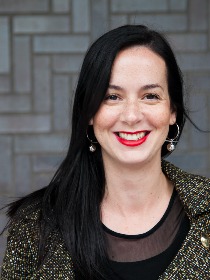The ingredients for active learning according to Maja Babić: student autonomy, collaboration with fellow students, and minimal teacher interference.

In New Ways of Teaching, lecturers talk about their innovative, creative, and effective teaching initiatives. From unusual teaching methods to new technologies—anything is possible. How do these ideas arise and what impact do they have on students? This month: active learning through collaborative writing.

Collaboration projects are, to put it mildly, not activities that will immediately enthuse students. Maja Babić, assistant professor of History and Theory of Architecture and Urbanism, has found a way to make it a bit more enticing. Through the ‘group meets individual’ project, students are encouraged to write an essay together with their fellow-students on a self-selected topic that interests them.
Breathing new life into essay writing
‘The background to the assignment stems from my own student days. I found working alone quite tedious and uninspiring, and I wanted to make sure the students in my class didn’t have the same experience. I strongly believe that we learn best when interacting with peers and under the—not too strict—guidance of the instructor.’
Doing things differently
‘Depending on the class I am teaching—whether first or second-year BA students or MA students—the complexity of the assignment changes. Yet, the basic rules remain the same: students must work together on a topic of their choosing (a city or work of architecture) in a group of four or five people. They are required to develop a research programme for their topic, delegate tasks among their fellow students, and then individually write their segments of the assignment while ensuring they are producing a coherent final document.
This approach breaks the project down into smaller segments, making it more manageable, while at the same time stimulating the mutual connection. In the end, the project is assessed with a group and individual mark, ensuring that those who perhaps put in a little more effort are not punished for the work of those who are less diligent.’
Catering to students’ needs
‘Because the assignment offers several topics students can choose from, everyone can choose the one that works best for them: some will examine a particular work of architecture, some will explore the profession of architect, and others will investigate the connection between politics and space. It caters to all preferences.
Most often, the assignments focus on the analysis of an architectural style in a non-European city—Art Nouveau in Buenos Aires is a typical first-year theme, for example— or an exploration of a disruptive event in the built environment —the construction of the Berlin wall, for example, or the public protests in Istanbul.
Ultimately, the students learn about the topic at hand. They carry out all the research and analyses of different cities and events, they practice their writing and presentation skills, and they learn to collaborate. While the latter is not always fun— although very often it actually is—it is a necessary skill to develop.’
Not everyone’s cup of tea
‘The feedback I received so far has been largely positive. The students explained that they appreciate the ability to be creative with their work and to work with fellow students whom they share interests with. Earlier versions of this assignment received some feedback regarding the way in which I provided the information of the project—which used to be a bit unstructured. But after adding more detailed instructions, things seem to be going well. Delegating tasks between students has been quite successful. On the rare occasion that they couldn’t figure things out, I was there to help them. They are, however, generally pretty good at knowing what they want to do and what they don’t care for. This means that my role in the project is very minimal, but I’m there to assist.
I can’t say this is the best approach for everyone, and that’s okay. It’s an assessment format in one class. It offers a different perspective on research.’
Reaping the rewards
‘As a teacher, I also benefit from the assignment: I see how students’ brains work, how they perceive architecture, how they come to different conclusions when they work together, and how they delegate work based on their preferences. Witnessing creativity is always a joy, and some projects have been absolutely brilliant in their development and presentation. I remember a group that based their research project on the music by Puerto Rican rapper Bad Bunny and his commentary on socioeconomic issues relating to the immigration and colonization of the island by wealthy Americans. It was absolute fun.
What this project teaches the students is that they learn to work in a group—sometimes even with friends—which introduces them to different perspectives. They are challenged by their peers, but everything is done in a safe environment. Or they discover that this is not a research format that works for them and how they should deal with that.’
More information
-
Read other editions of New Ways of Teaching
| Last modified: | 18 March 2025 08.45 a.m. |
More news
-
24 March 2025
UG 28th in World's Most International Universities 2025 rankings
The University of Groningen has been ranked 28th in the World's Most International Universities 2025 by Times Higher Education. With this, the UG leaves behind institutions such as MIT and Harvard. The 28th place marks an increase of five places: in...
-
05 March 2025
Women in Science
The UG celebrates International Women’s Day with a special photo series: Women in Science.
-
16 December 2024
Jouke de Vries: ‘The University will have to be flexible’
2024 was a festive year for the University of Groningen. In this podcast, Jouke de Vries, the chair of the Executive Board, looks back.
